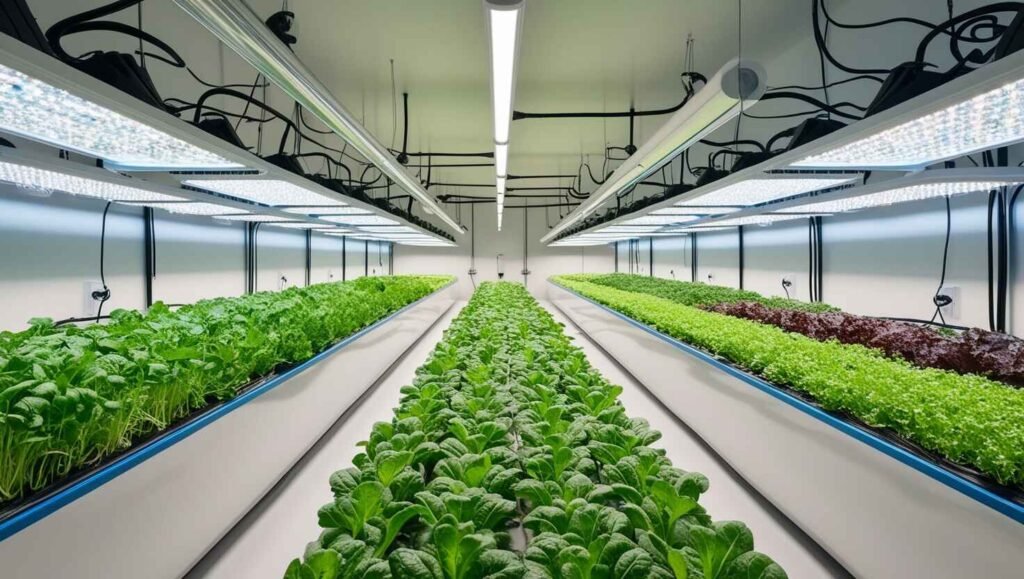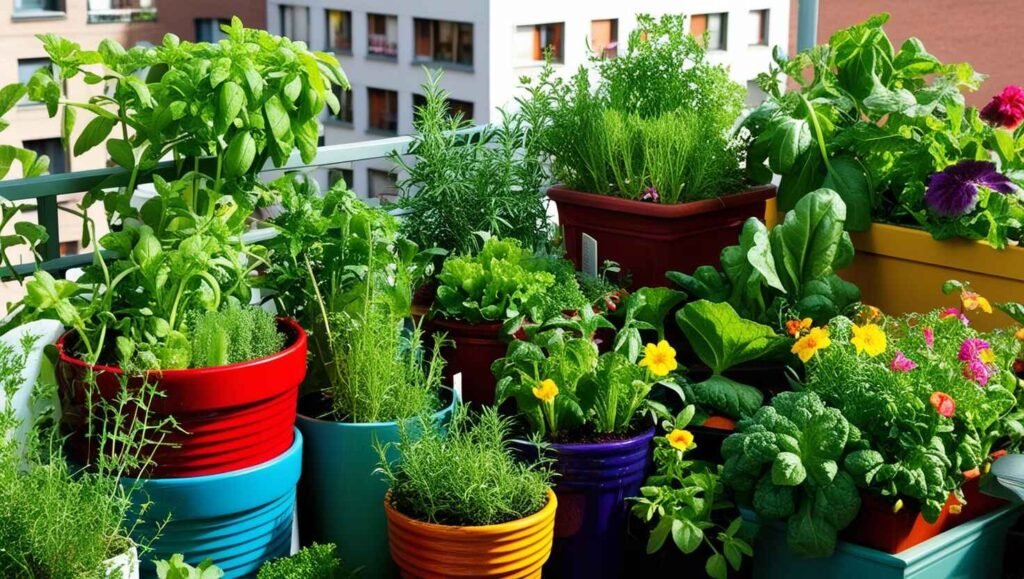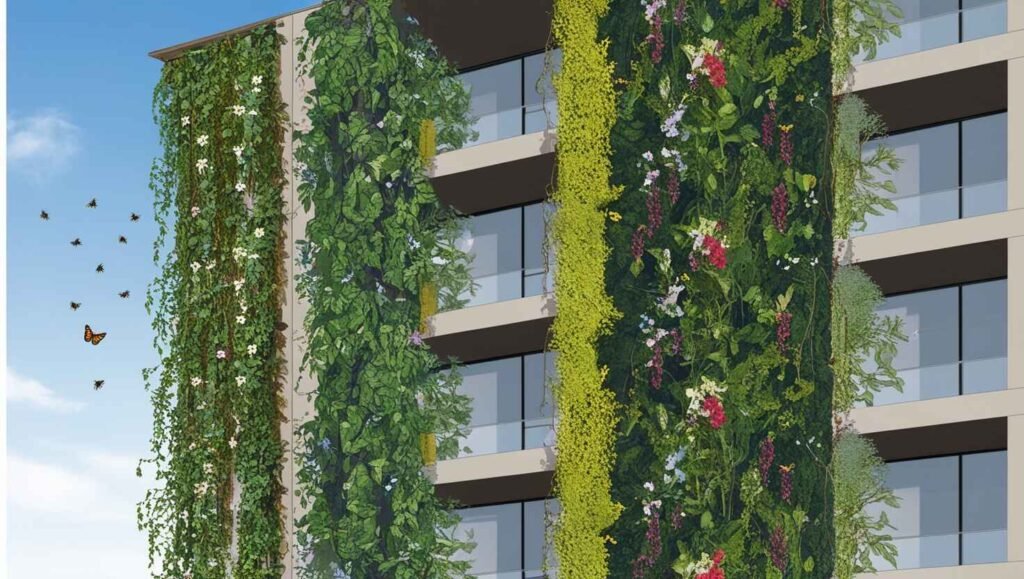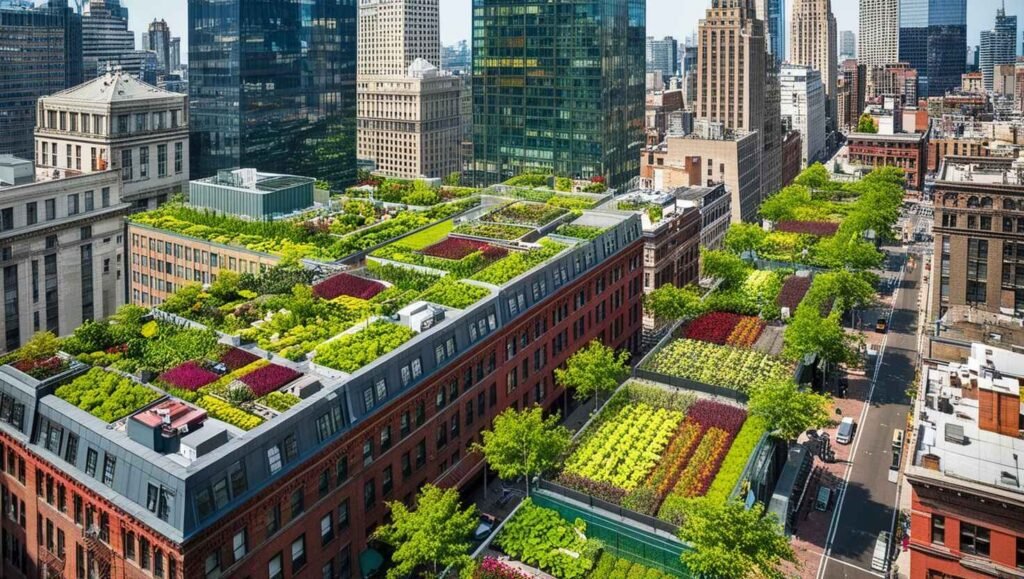What is Urban Gardening? Understanding the Benefits of urban gardens, Types, and Challenges
Urban gardening: a stark contrast to the concrete jungle that surrounds us. In the midst of towering buildings and bustling streets, urban gardening offers a breath of fresh air – quite literally. It’s about transforming small spaces into green oases, where plants thrive and communities flourish with urban agriculture, community gardens, urban vegetable gardens, and urban farms.
We’ll explore how it allows city dwellers to reconnect with nature, embrace sustainability, and cultivate their own food in limited spaces. Whether you have a tiny balcony or just a few windowsills to spare, urban gardening in containers opens up endless possibilities for growing your own herbs, vegetables, and even flowers.
So let’s dig in and discover the world of urban gardening together, with community, pots, water, and sun!

Key Takeaways
- Urban gardening is a practice of growing plants in urban areas, and it offers numerous benefits for individuals, communities, and the environment.
- By engaging in urban gardening, individuals can have access to fresh, organic produce, improve mental well-being, and contribute to a greener and more sustainable city.
- There are various types of urban gardens, including rooftop gardens, community gardens, and vertical gardens, each with its own unique advantages and challenges.
- Urban gardening plays a significant role in mitigating the effects of climate change, reducing air pollution, and promoting biodiversity in urban environments.
- While urban gardening has many advantages, it also comes with challenges such as limited space, soil contamination, and lack of access to resources. However, these challenges can be overcome with proper planning and innovative solutions.
- To start an urban garden, individuals should consider factors such as available space, sunlight exposure, water source, and the types of plants they want to grow. It’s important to start small and gradually expand the garden as experience and knowledge increase.
Understanding Urban Gardening
Urban gardening refers to the practice of growing plants and vegetables in urban areas using pots, water, and sun. It involves cultivating plants in small spaces like balconies, rooftops, or even indoor areas. Urban gardening allows individuals to grow their own food and contribute to a sustainable lifestyle.
The history of urban gardening dates back centuries, with ancient civilizations such as the Babylonians and Egyptians practicing it. During World War I and II, victory gardens were popularized as a means of promoting self-sufficiency during times of food scarcity. However, it was in the 1970s that the modern urban gardening movement gained momentum as a response to environmental concerns and limited access to fresh produce in cities.
While urban gardening focuses on smaller-scale practices within an urban setting, there is also the concept of urban farming which concentrates on large-scale agricultural practices within cities. Urban farming aims to address food security issues by producing crops for local consumption. This can be achieved through community gardens, rooftop farms, or vertical farming techniques.
Urban gardening offers numerous benefits beyond just providing access to fresh produce. It helps create green spaces in concrete jungles while improving air quality and reducing pollution levels. Engaging in this activity promotes physical activity and mental well-being among individuals who participate in community garden spaces and urban vegetable gardens.
Benefits of Urban Gardens
Urban gardening offers many benefits that contribute to both individual well-being and the overall sustainability of communities. Let’s explore some of these advantages in more detail.
Mental Health
Engaging in community urban gardening can have a positive impact on mental health. Spending time outdoors and connecting with nature promotes relaxation, reducing stress and anxiety levels. Imagine stepping outside your apartment or office building into a small garden oasis, surrounded by plants and greenery. The soothing sights, sounds, and smells of nature can provide a much-needed escape from the hustle and bustle of city life.
Gardening activities themselves also offer therapeutic benefits. Tending to plants provides a sense of purpose and accomplishment, boosting self-esteem. Whether it’s planting seeds, watering plants, or harvesting vegetables, each task contributes to the growth and development of your garden. This tangible progress in the garden can bring about a sense of fulfillment and satisfaction.
Reducing Carbon Footprint
Urban gardening plays an important role in reducing our carbon footprint. By promoting locally grown food from the garden, which requires less transportation compared to produce shipped from distant locations, we reduce greenhouse gas emissions associated with long-distance travel. Growing plants in cities also helps improve air quality as they absorb carbon dioxide during photosynthesis while releasing oxygen.
Urban gardeners contribute to minimizing methane emissions from landfills by composting organic waste rather than sending it for disposal. Composting not only diverts waste from landfills but also produces nutrient-rich soil amendments that support plant growth without relying on synthetic fertilizers in the garden.
Promoting Regenerative Practices
Urban gardening encourages regenerative practices that promote sustainability within communities. Composting organic waste in the garden allows us to recycle valuable nutrients back into the soil instead of depleting them through conventional farming methods reliant on chemical inputs.
Rainwater harvesting is another regenerative practice commonly employed in urban gardens where space is limited for large-scale irrigation systems.
Types of Urban Gardens
Urban gardening has gained popularity in recent years as a way for city dwellers to reconnect with nature and grow their own food. There are several types of urban gardens that can be implemented, depending on the available space and resources.
Container Gardens
One popular type of urban garden is the container garden. As the name suggests, this method involves growing plants in containers such as pots, raised beds, or even repurposed items like buckets or old furniture in a garden. Container gardens are ideal for urban environments because they allow plants to be grown in limited spaces.
The flexibility and mobility offered by container gardens make them well-suited for urban gardening. They can easily be moved around to take advantage of sunlight or protect plants from harsh weather conditions. This adaptability is especially valuable when dealing with changing environmental factors in the garden.
For example, if a garden balcony receives direct sunlight during certain times of the day but becomes shaded later on, containers can be shifted accordingly to ensure optimal sun exposure for plant growth.

Planning and Designing
Successful urban gardening requires careful planning and design to optimize space utilization. When embarking on an urban gardening project, it’s important to consider factors such as sunlight exposure, wind patterns, and available water sources.
Efficient use of vertical space in a garden is crucial in maximizing yields within limited areas. Vertical planting techniques like trellises or hanging baskets enable gardeners to make use of walls or other vertical surfaces for growing vines or trailing plants.
Companion planting – where compatible crops are planted together – helps maximize productivity while deterring pests naturally without relying heavily on chemical pesticides. Crop rotation should be practiced in the garden over time to prevent nutrient depletion and minimize disease buildup in the soil.
Impact of Urban Gardening
Urban gardening has a positive impact on the environment and communities in various ways. One significant effect of creating a garden is the creation of habitats for beneficial insects, birds, and other wildlife. By incorporating native plants into urban gardens, gardeners can attract pollinators such as bees and butterflies, which are essential for plant reproduction. This not only helps to increase crop yields but also supports biodiversity in urban environments.
In addition to providing food sources for wildlife, creating habitat through urban gardening contributes to the ecological balance of surrounding areas. It allows different species to coexist and thrive together in a garden, promoting a healthier ecosystem overall. For example, by planting flowers that attract ladybugs or lacewings, gardeners can naturally control pests without resorting to harmful pesticides.
Another way that urban gardening makes a positive impact is by embracing sustainable ideas. Gardeners can use recycled materials for planters and compost bins instead of contributing to waste accumulation. This not only reduces landfill space but also promotes a circular economy where resources, including garden waste, are reused rather than discarded.
Furthermore, adopting organic pest control methods like companion planting or introducing beneficial insects in the garden minimizes reliance on chemical pesticides that harm both human health and the environment. These natural approaches help maintain a balanced ecosystem within urban gardens.
Moreover, utilizing renewable energy sources such as solar-powered irrigation systems or LED grow lights can significantly reduce energy consumption associated with urban gardening practices.
Challenges of Urban Gardening
Urban gardening comes with its fair share of challenges that gardeners need to be aware of and address. These challenges include contaminated soil, soil erosion, pests, diseases, and garden.
One challenge faced by urban gardeners is contaminated soil. It’s important for gardeners to be cautious about potential contamination from previous land uses or nearby pollution sources. Conducting soil tests in a garden can help identify contaminants and determine the appropriate remediation measures. In areas with contaminated soil, raised beds or container gardens filled with fresh soil can serve as alternatives.
Another challenge is soil erosion, which can pose a risk to urban gardens. To prevent erosion in a garden, practices such as mulching, terracing, or using cover crops are beneficial. Planting deep-rooted vegetation helps stabilize the structure of the soil and reduces runoff during heavy rainfall. Implementing proper drainage systems also minimizes the risk of erosion in urban garden plots.
Furthermore, pests and diseases are common challenges that urban gardeners face. It’s essential for them to be aware of these issues in order to protect their plants effectively. Integrated pest management techniques involve using natural predators, organic sprays, or physical barriers in the garden to control pests without relying heavily on chemical pesticides. Regular monitoring and early detection play crucial roles in preventing the spread of diseases and minimizing crop damage.
Addressing these challenges requires knowledge, planning, and proactive measures from urban gardeners who aim to create thriving green spaces within an urban environment.
Tips for Starting an Urban Garden
Getting Involved
Urban gardening offers numerous opportunities for community involvement. One way to get involved is by participating in shared gardens or volunteering in local projects. These initiatives not only allow individuals to contribute to the greening of their neighborhoods but also provide a chance to connect with like-minded people who share a passion for gardening.
Another way to engage in urban gardening is by joining gardening clubs or attending workshops. These spaces offer valuable learning experiences where individuals can acquire knowledge and skills from experienced gardeners. Whether it’s learning about soil composition, pest control, or plant care, these interactions foster growth and development as urban gardeners.
Collaborating with neighbors in urban farming initiatives is another excellent way to strengthen social connections within communities and engage in gardening. By working together on neighborhood gardens or sharing resources like tools and seeds, residents can build stronger bonds and create a sense of unity among themselves.
Understanding Conditions
To ensure successful urban gardening, it’s crucial to understand the specific environmental conditions of the chosen location. Factors such as sunlight exposure, temperature fluctuations, microclimates, and garden play significant roles when selecting plants that will thrive in an urban environment.
Sunlight exposure is particularly important for city dwellings with limited access to direct sunlight due to tall buildings or shaded areas caused by nearby structures and garden. Therefore, choosing plants that can tolerate partial shade or finding creative solutions like vertical gardens can help maximize sun exposure for optimal plant growth.
Temperature fluctuations are another consideration when planning an urban garden. Cities often experience heat island effects where temperatures tend to be higher than surrounding rural areas due to concrete surfaces absorbing heat during the day and releasing it at night. Selecting garden plants that are resilient against extreme temperatures will increase their chances of survival in this challenging environment.
Lastly, understanding microclimates within cities is essential for successful gardening endeavors.

Importance of Urban Gardening
Urban gardening is not just a hobby or a trendy activity; it holds significant importance in our society and in our lives. By supporting urban gardening initiatives, governments and local authorities can contribute to the well-being of their communities. They can provide land or financial incentives to encourage people to start gardens in urban areas. Educational programs and resources can be developed to promote sustainable gardening practices among urban gardeners.
Partnerships between urban gardeners, businesses, and community organizations also play a crucial role in creating a supportive ecosystem for urban gardening. These partnerships foster collaboration, knowledge sharing, resource pooling, and garden that benefit everyone involved.
In addition to its societal impact, urban gardening has immense importance in our personal lives as well. One of the key benefits is promoting food security and self-sufficiency in urban areas through gardening. Many neighborhoods lack access to fresh produce due to limited grocery options or being located in food deserts. Urban gardening helps address this issue by providing individuals with the opportunity to grow their own fruits, vegetables, herbs, and spices right at home.
Engaging in urban gardening also fosters a sense of connection with nature. In today’s fast-paced world dominated by concrete jungles, having green spaces where we can interact with plants and soil brings us closer to the natural world around us. It provides an escape from the stresses of daily life while promoting relaxation and mental well-being in the garden.
Furthermore, practicing sustainable living through activities like composting organic waste from our gardens reduces environmental impact by minimizing landfill waste production.
Factors to Consider in Urban Gardening
There are several factors that aspiring gardeners should consider. One of the most important factors is location. Urban gardening can be practiced in various locations such as balconies, rooftops, community gardens, or even indoor spaces with sufficient light. The choice of garden location depends on factors like available space, sunlight exposure, accessibility, and local regulations.
Each location presents unique opportunities and challenges for urban gardeners. For example, if you have a small balcony or rooftop space, you may need to utilize vertical gardening techniques or choose plants that are suitable for containers. On the other hand, if you have access to a community garden plot or a larger outdoor area, you may have more flexibility in terms of plant selection and layout.
Another factor to consider is resources. Fortunately, there are numerous online resources that provide guidance on urban gardening techniques, plant selection, and troubleshooting common issues. These resources can be especially helpful for beginners who are just starting out with their urban gardens.
In addition to online resources,local agricultural extension offices or horticultural societies offer valuable advice tailored to specific regions. They can provide information about soil conditions in your garden area and recommend crops that thrive well locally.
Books about urban gardening also serve as excellent sources of information for urban gardeners looking to expand their knowledge base further. Workshops and gardening forums allow enthusiasts from all walks of life to come together and share their experiences while learning from one another.
Final Remarks
In conclusion, urban gardening is a powerful tool that allows individuals to reconnect with nature, improve their well-being, and contribute to the sustainability of their communities. By transforming small spaces into thriving gardens, urban gardeners can grow their own fresh produce, reduce food miles, and promote a healthier lifestyle. Urban gardening creates opportunities for social interaction and community engagement, fostering a sense of belonging and unity among neighbors.
To get started with your own urban garden, consider the available space, sunlight exposure, and water accessibility in your area. Start small and gradually expand as you gain experience. Remember to choose plants that are suitable for your climate and soil conditions. Don’t be afraid to experiment and learn from your mistakes in the garden along the way.
So why not join the growing movement of urban gardeners? By taking action today, you can make a positive impact on your environment and community while enjoying the many benefits that urban gardening has to offer. Happy gardening!

Frequently Asked Questions
What is urban gardening?
Urban gardening refers to the practice of growing plants and crops in urban areas, such as cities or towns, where space may be limited. It involves using creative techniques like rooftop gardens, vertical farming, or community gardens to cultivate green spaces within an urban environment.
How does urban gardening benefit communities?
Urban gardening offers numerous benefits to communities. It helps improve air quality by reducing pollution levels and provides access to fresh produce from the garden, promoting healthier diets. It creates opportunities for social interaction among neighbors and enhances the aesthetic appeal of urban areas.
What are some types of urban gardens?
There are various types of urban gardens you can explore. These include rooftop gardens on buildings, balcony or terrace gardens in apartments, indoor hydroponic setups using artificial lighting systems, community gardens shared among residents in a neighborhood, and even pocket parks converted into small green spaces.
How does urban gardening impact the environment positively?
Urban gardening has a positive environmental impact in several ways. By introducing more vegetation into concrete jungles, it helps mitigate heat island effects by lowering temperatures. Moreover, it contributes to biodiversity conservation by providing habitats for birds and insects while reducing stormwater runoff through natural absorption.
What challenges should I expect when starting an urban garden?
Starting an urban garden comes with its fair share of challenges. Limited space can pose restrictions on what you can grow; therefore choosing suitable plants becomes crucial. Soil quality may also be poor due to contamination risks from nearby pollution sources. Managing water usage efficiently and dealing with pests can be challenging but not insurmountable with proper planning and research.
Are there any tips for successfully starting an urban garden?
Certainly! Here are a few tips: start small if you’re new to gardening; choose plants that thrive well in your specific climate conditions; utilize vertical space creatively with trellises or hanging baskets; consider using raised beds or container gardening options.


Very informative text
garden improve sustainability in the urban area